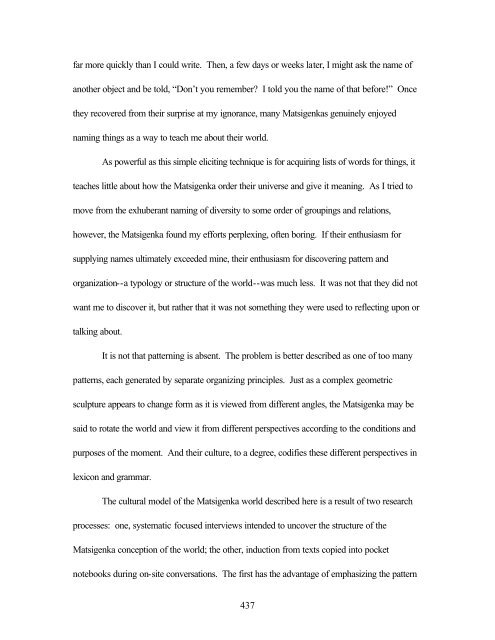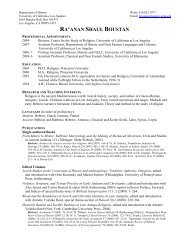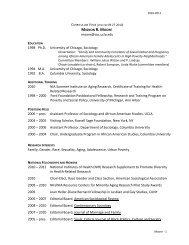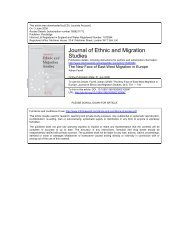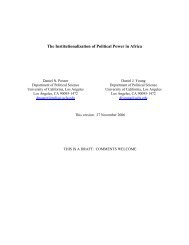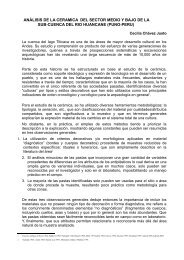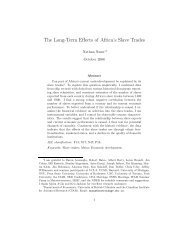433 Chapter Seven Cosmos For the Matsigenka of Shimaa, kameti ...
433 Chapter Seven Cosmos For the Matsigenka of Shimaa, kameti ...
433 Chapter Seven Cosmos For the Matsigenka of Shimaa, kameti ...
You also want an ePaper? Increase the reach of your titles
YUMPU automatically turns print PDFs into web optimized ePapers that Google loves.
far more quickly than I could write. Then, a few days or weeks later, I might ask <strong>the</strong> name <strong>of</strong><br />
ano<strong>the</strong>r object and be told, “Don’t you remember? I told you <strong>the</strong> name <strong>of</strong> that before!” Once<br />
<strong>the</strong>y recovered from <strong>the</strong>ir surprise at my ignorance, many <strong>Matsigenka</strong>s genuinely enjoyed<br />
naming things as a way to teach me about <strong>the</strong>ir world.<br />
As powerful as this simple eliciting technique is for acquiring lists <strong>of</strong> words for things, it<br />
teaches little about how <strong>the</strong> <strong>Matsigenka</strong> order <strong>the</strong>ir universe and give it meaning. As I tried to<br />
move from <strong>the</strong> exhuberant naming <strong>of</strong> diversity to some order <strong>of</strong> groupings and relations,<br />
however, <strong>the</strong> <strong>Matsigenka</strong> found my efforts perplexing, <strong>of</strong>ten boring. If <strong>the</strong>ir enthusiasm for<br />
supplying names ultimately exceeded mine, <strong>the</strong>ir enthusiasm for discovering pattern and<br />
organization--a typology or structure <strong>of</strong> <strong>the</strong> world--was much less. It was not that <strong>the</strong>y did not<br />
want me to discover it, but ra<strong>the</strong>r that it was not something <strong>the</strong>y were used to reflecting upon or<br />
talking about.<br />
It is not that patterning is absent. The problem is better described as one <strong>of</strong> too many<br />
patterns, each generated by separate organizing principles. Just as a complex geometric<br />
sculpture appears to change form as it is viewed from different angles, <strong>the</strong> <strong>Matsigenka</strong> may be<br />
said to rotate <strong>the</strong> world and view it from different perspectives according to <strong>the</strong> conditions and<br />
purposes <strong>of</strong> <strong>the</strong> moment. And <strong>the</strong>ir culture, to a degree, codifies <strong>the</strong>se different perspectives in<br />
lexicon and grammar.<br />
The cultural model <strong>of</strong> <strong>the</strong> <strong>Matsigenka</strong> world described here is a result <strong>of</strong> two research<br />
processes: one, systematic focused interviews intended to uncover <strong>the</strong> structure <strong>of</strong> <strong>the</strong><br />
<strong>Matsigenka</strong> conception <strong>of</strong> <strong>the</strong> world; <strong>the</strong> o<strong>the</strong>r, induction from texts copied into pocket<br />
notebooks during on-site conversations. The first has <strong>the</strong> advantage <strong>of</strong> emphasizing <strong>the</strong> pattern<br />
437


